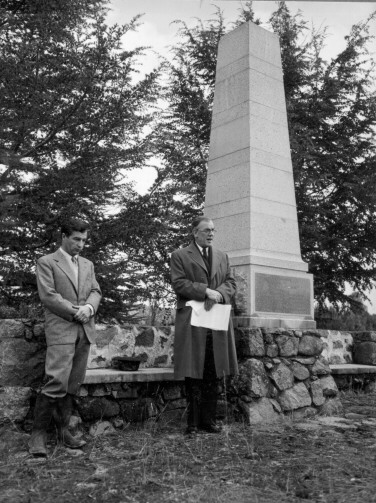William James Farrer |
Farrer was born in England at Docker, Westmoreland. A brilliant mathematics student, he began studying medicine but contracted tuberculosis and migrated to Australia in 1870 seeking a drier climate. He first worked as a tutor to George Campbell's children at Duntroon, before qualifying as a surveyor in 1875 and working for the NSW Deparmtment of Lands until 1886.
In 1882 he married Nina, daughter of Count Leopold Fane De Salis of Cuppacumbalong, Tharwa (now part of the ACT). As a wedding present, De Salis gave his daughter 97 hectares of this property, which Farrer named Lambrigg.
Farrer designed the Lambrigg homestead, which seems to have been built in stages between 1886 and 1894. The original part of the homestead, now the downstairs area, may have been used as his laboratory until a separate building was constructed, possibly in 1893.
Farrer’s experimental wheat paddocks covered about 6–8 acres from the new laboratory building to the Murrumbidgee River. A three-acre paddock between the laboratory and the main dam was the area in which Farrer concentrated his experiments. Very little evidence of this activity remains on the site.
From at least 1873 Farrer was interested in agriculture, and soon realised that many of Australia’s wheat industry problems were due to the unsuitability of the soft, rust-prone types of wheat sown. By 1882 he was planning experiments to improve the existing varieties by careful selection. From Europe and America he learned about the new cross-breeding experiments, and in 1889 Farrer’s first Australian experiments coincided with the country’s worst wheat crop ever. In 1890 Farrer wrote to the first Intercolonial Rust in Wheat Conference, insisting that cross-breeding would not only improve wheat’s resistance to rust but also result in a better flour for baking.
During the 1890s he worked with FB Guthrie to test his new strains of wheat for flour yield and baking qualities. In 1898 he was appointed as wheat experimentalist to the Department of Agriculture. The flour millers preferred softer wheats that produced more flour, however, and in 1901 Farrer bred Federation, a hybrid of his own ‘hard’ wheat with a softer variety. It was the leading variety of wheat planted throughout Australia from 1910 to 1925.
Farrer-bred wheat increased fourfold the wheat acreage in New South Wales from 1897 to 1915, allowing expansion into the drier, rust-prone western districts. The general belief that Farrer bred rust-resistant wheat is not strictly correct. His new varieties actually avoided being infected by the fungus by maturing earlier, and only a few also had true rust-resistant properties.
Farrer’s other significant contribution to agricultural science was his systematic experimentation in genetic inheritance of disease resistance, grain quality and other plant factors. He did not publish in scientific journals, though his articles were regularly published in the Agricultural Gazette during his term as wheat experimentalist, and a paper he wrote in 1898 comprehensively described his aims and achievements to date.
Farrer died from heart disease, and was buried at a site he had selected on the rocky ridge overlooking his experimental paddocks – and today, part of Tuggeranong. Accounts of his death and burial are quoted by Barrow and Russell. Nina lived at Lambrigg until her death, although she sold the property to the Commonwealth Government in 1924 and leased it back for a peppercorn rent. She is buried beside her husband. They had no children.
On 16 January 1939 a granite column beside the graves was unveiled. The inscription reads:
This Memorial to William James Farrer – 1845–1906 – overlooking the scene of his labours, was erected by the Commonwealth as a tribute to his national work in the breeding and establishment of improved varieties of Australian wheat.
Memorial services are held occasionally, notably on the 50th anniversary of Farrer’s death and in 1951 when his great-nephew visited Canberra for the Jubilee Law Conference.
William Farrer is well remembered nationally, but especially so in the Queanbeyan district which he supported as the site for the new national capital. The Queanbeyan Historical Museum holds many resources and some personal artefacts.
In addition to the commemorative column at the graves, other local memorials include streets in Canberra and Queanbeyan, a Canberra suburb and a bronze bust by famous sculptor Rayner Hoff that was erected in Monaro Street, Queanbeyan in 1935. On 31 March 2006, a plaque was added to the bust, noting his work as a surveyor before his concentration on wheat science. The first Farrer Memorial Oration was delivered in Queanbeyan by the then Prime Minister the Rt Hon Joseph Lyons, MP, on 3 April 1936. The silver medallion presented to Lyons was later donated to the Basser Library, Australian Academy of Science, Canberra.
More information
SECONDARY SOURCES | |
|---|---|
| Australian Dictionary of Biography, vol. 8, Cl-Gib, pp. 471–473. ACTHL Location: H 920.094 AUST | |
Barrow, Graeme | ACTHL Location: H 994.71 BARR |
McIndoe, S.L. | ACTHL Location: H 994.7 CAN |
Sheedy, P.B. and Percy, E.A. | ACTHL Location: H 994.47 SHEE |
‘William and Nina – The Farrer Partnership’ | ACTHL Location: H 994.7 CANB |
PRIMARY SOURCES | |
|---|---|
The National Library of Australia holds several manuscript items relating to Farrer, including some correspondence at MS 33 and his field book at MS 5856. | |
The Mitchell Library of the State Library of NSW holds a significant collection of Farrer’s correspondence at ML A3143. |


